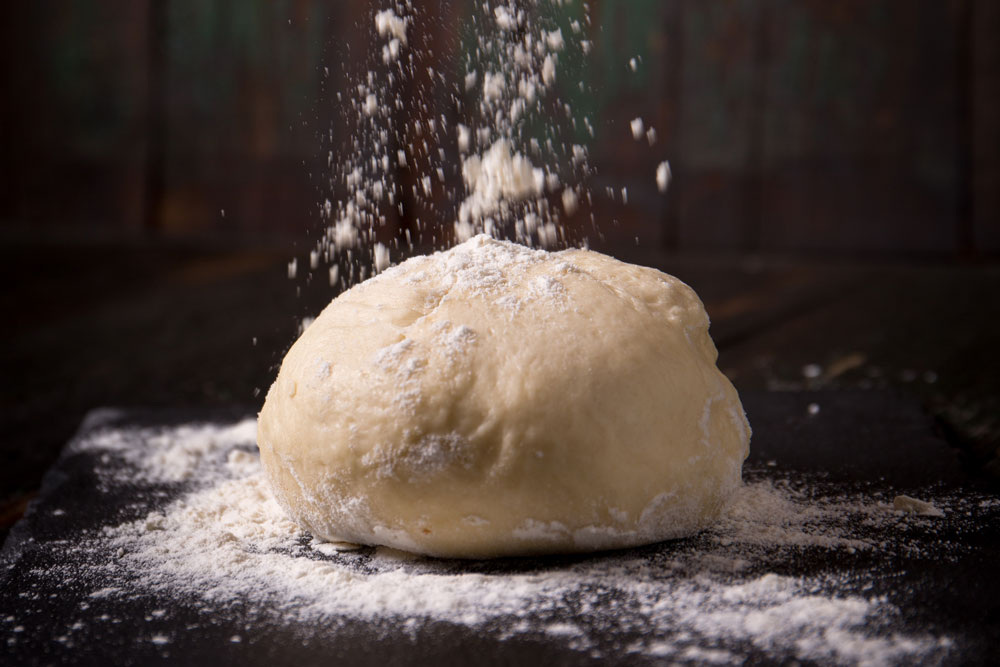By Tom Lehmann
Editor’s note: The late Tom “The Dough Doctor” Lehmann was the dough making sage of the pizza industry and happily shared his wisdom with PMQ’s readers for more than 20 years. We believe Tom would still write for us in pizza heaven if he could, so we’re reprinting this (slightly edited) article he penned in 2008. It’s both timeless and, in light of current inflationary prices, as timely as ever.
I’m sure that most of you are wondering if the price of flour will ever come back down again. For many, it can’t come down fast enough. With the high costs of cheese, meats and other ingredients, our bottom lines aren’t just hurting; they’re in serious trouble. Some pizzeria operators might be looking to sidestep flour costs by using some other type of flour. Sadly, you can’t blend other types of flour into your wheat flour to come up with a lower-cost alternative. But you can blend different types of flours into your wheat flour to make some truly unique pizza crusts with different flavor and textural properties and charge more for them.
When making a blended flour crust, you can add any of the nonwheat flours at replacement levels of up to 25% of the total wheat flour.
Considering the Alternatives
First, you need to have a full understanding of the flour that you presently use. Wheat flour consists of several different groups of proteins, two of which—glutenin and gliadin—are essential to pizza making. When hydrated with water and mixed, they produce the structure-forming material that we call gluten in our dough. Gluten holds dough together, allowing it to be sheeted, pressed, stretched and tossed without coming apart. It also contributes to the bite, or chewiness, of the baked pizza.
Other grains contain these specific gluten-forming proteins but in such a low quantity that forming and shaping dough becomes problematic. These include rye, barley and triticale, a wheat-rye cross. While rye flour can be used to make pizza, rye dough is sticky and weak, making it difficult to handle or shape.
Related: The secrets to creating a better crumb structure
Semolina flour has gluten-forming proteins, too, but the type of gluten derived from durum flour is extremely tight, not very elastic or stretchable. That makes for dough that’s difficult to shape well and has a lot of memory. Also, after baking, this flour can impart extreme toughness to the finished crust.
With a wheat and nonwheat blend, the dough will be somewhat weaker than a normal white-flour dough, probably requiring less mixing time.
Barley flour contains gluten-forming proteins, but, again, the level of gluten-forming protein is so low that the doughs are weak and sticky, plus they’re more expensive than wheat flours.
Some other nonwheat flours include buckwheat, corn flour, rice flour, quinoa and amaranth. Others that can be incorporated into the dough formulation—providing uniquely flavored crusts or crusts with a “healthy” or exotic-sounding appeal—include flaxseed meal, soy flour, sorghum flour, oat flour and spelt flour.

Getty Images
Doing the Math
When making a blended flour crust, you can add any of the above-mentioned nonwheat flours at replacement levels of up to 25% of the total wheat flour. So if you use 50 pounds of wheat flour, you can replace up to 12.5 pounds of it with one or more of these other flour types to produce a uniquely flavored crust.
Something to keep in mind when working with nonwheat blends: They will exhibit an affinity for water in much the same way the wheat flour does; in many cases, it may actually be greater than that of flour. To determine how much water needs to be added to the dough, place a known quantity, such as 10 ounces, of the nonwheat flour material into a small bowl, then add 5 ounces of water and stir until the water is mixed into the material. If the resulting paste is too thick and/or too dry, stir in another ounce of water. Continue doing this until the material looks to be well-hydrated and allow the mix to hydrate for 60 minutes. Then check it again for consistency and add more water if necessary. If you add more water, remember to allow the material to hydrate again for another hour before checking it for correct hydration.
Related: How to create a crispy pizza crust
When the material has the consistency of very thick oatmeal, it’s properly hydrated. You can calculate the absorption percent by dividing the weight of water added by the weight of the nonwheat flour used, then multiplying by 100. For example, if you started with 10 ounces of nonwheat material and ended up adding 7 ounces of water before it was fully hydrated, you would divide 7 by 10 and multiply by 100—in this case, 70% absorption.
To use this in calculating your dough absorption, multiply the white flour weight by 0.56 to find the correct absorption for that portion of the flour blend, and then multiply the nonwheat flour weight by 0.70 to find the correct absorption for that portion of the flour blend. Add up the two weights and you’ll have the correct amount of water to add to the dough with that flour blend.

Getty Images
Do Some Experimenting
When using nonwheat flours, you’ll want to experiment a little on smaller dough batches to determine what changes are needed to complement the nonwheat flour. An increase in sweetness might help. In this case, the type of sweetener used, such as honey, white sugar, brown sugar, molasses or malt syrup, could be an important consideration, as it can influence the flavor of the crust, the perceived sweetness, or the perception of “healthful” or “natural” to the consumer.
The use of butter, margarine or butter-flavored oil (instead of olive oil) can also have a significant impact on crust flavor, especially when flaxseed meal, oat flour, barley flour or soy flour is used.
With a wheat and nonwheat blend, the dough will be somewhat weaker than a normal white-flour dough, probably requiring less mixing time. Be sure to mix the dough just until a smooth dough appearance is achieved, and then take the dough directly to the bench for scaling and balling.
To use the dough on the same day, put it into plastic dough boxes and lightly oil the tops of the dough balls, then stack and nest the boxes and let them set at room temperature for 90 minutes before forming the dough balls into pizza skins.
Related: How to solve the problem of wet, sticky pizza dough
If you refrigerate and store the dough overnight, cross-stack the dough boxes in the cooler for 90 minutes, and then down-stack and nest the boxes to prevent drying. Allow the dough to remain in the cooler for 18 to 24 hours. To use the dough, remove a quantity sufficient for a three-hour period and place at room temperature to temper for two hours. Then begin shaping into dough skins. The dough will remain good to use over the next three hours. Any unused dough may be opened into skins, placed onto screens and held in the cooler for several hours until needed for making pizzas. Due to the weakness of these doughs, they should not be held in the cooler for more than one day.
[Nonwheat blends] will exhibit an affinity for water in much the same way the wheat flour does; in many cases, it may actually be greater than that of flour.
When making a pizza with any of these crusts, you may also need to experiment with the baking time. Since these crusts will be more dense than your regular white-flour crusts, they should be allowed to bake for a slightly longer time, ideally at a lower temperature (450° to 500°F), assuming you’re using a deck oven. But, in most cases, for practical purposes, you’ll want to keep the oven settings the same as you use for your regular pizza production. In that case, consider baking these special pizzas on a screen or a baking disk in your deck oven, which will allow for a longer baking time without burning the pizza. Then “deck” the pizza for the last 45 to 60 seconds of baking. (“Decking” involves removing the pizza from the screen or disk and placing it directly on the oven hearth to further crisp it.)
None of these approaches will reduce your flour costs, but they may help you to develop some new or different offerings that will command a better price, thus boosting your bottom line. Additionally, the right combination might appeal to a different group of customers that you didn’t previously attract, thus expanding your customer base. In these trying times, we need all the help we can get with those bottom-line numbers.
The late Tom “The Dough Doctor” Lehmann was a longtime columnist for PMQ and served as director of bakery assistance for the American Institute of Baking (AIB).













